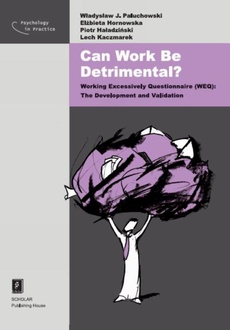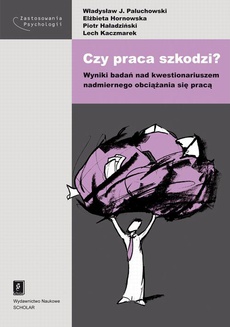INNE EBOOKI AUTORA

-22%
Can Work Be Detrimental? Working Excessively Questionnaire (WEQ): The Development and Validation
Wydawca:
Format:
pdf, ibuk
Psychology in Practice
For some, excessive workload is a source of satisfaction, while for others it stems from the desire to meet one's own and external expectations.
Sometimes a fulfilling job fulfills one's life because it provides everything that is needed to be happy. Work can be an accepted way of escaping from one's emotional problems. In some cases excessive workload results from the fear of losing a job and sometimes from poor work organization. Another reason to work excessively may be that it is financially worthwhile. Workaholism is a harmful consequence of excessive workload. Only deep and thorough analysis differentiates workaholism from excessive workload.
The formal structure of the monograph reflects the development of the stages of the Working Excessively Questionnaire (WEQ) in three chapters. Chapter 1 presents the relationship between excessive workload and workaholism the causes and negative effects of excessive focus on work, and possible theoretical explanations of the phenomenon of workaholism. Chapter 2 discusses the various research methods used in studies of workaholism and describes the foundation of the WEQ and the process of working on its final version. And chapter 3 discusses the correlates of the four scales of the Working Excessively Questionnaire.
| Rok wydania | 2014 |
|---|---|
| Liczba stron | 128 |
| Kategoria | Psychologia ogólna |
| Wydawca | Wydawnictwo Naukowe Scholar |
| Seria | 978-83-7383-704-1 |
| ISBN-13 | 978-83-7383-704-1 |
| Numer wydania | 1 |
| Język publikacji | angielski |
| Informacja o sprzedawcy | ePWN sp. z o.o. |
POLECAMY
Ciekawe propozycje
Spis treści
| Preface | 9 |
| Chapter | 1 |
| Excessive workload | 13 |
| Work and its place in life 13 | |
| The psychopathology of work 16 | |
| Workload 16 | |
| Work addiction 21 | |
| Workaholism as a behavioral addiction (non-chemical addiction) 26 | |
| Workaholism: The moderating effects of individual and contextual factors 28 | |
| The most obvious negative consequences of workaholism | 33 |
| Subjective effects 33 | |
| Work-family conflict 34 | |
| The organizational effects 36 | |
| Theoretical explanations of workaholism | 36 |
| Chapter | 2 |
| Refinement and further validation of the working excessively | |
| questionnaire (WEQ) | 39 |
| Various measures of workaholism 39 | |
| Questionnaire to measure work addiction (WART) 39 | |
| Spence and Robbins’ scales to test workaholism (WorkBAT) 41 | |
| Abbreviated scale to test workaholism (WorkBAT-R) 42 | |
| Sub-scale of the questionnaire Schedule for Nonadaptive Personality | |
| (SNAP-Work) | 42 |
| Scales for testing susceptibility to workaholic behaviors (SWBT) 43 | |
| Dutch Work Addiction Scale (DUWAS) | 44 |
| Workaholism Analysis Questionnaire (WAQ) 44 | |
| Bergen Work Addiction Scale (BWAS) 45 | |
| The Scale of Being Absorbed by Work (SZAP) 46 | |
| Multidimensional Questionnaire for Workaholism Assessment (WKOP) | 46 |
| Conclusions | 47 |
| Methodological consequences | 48 |
| Conceptualizing our questionnaire 49 | |
| Item pool development 50 | |
| Final refinement of the questionnaire | 52 |
| The sample | 52 |
| Scale statistics | 54 |
| Scale reliabilities and intercorrelations | 56 |
| Criterion analysis 56 | |
| Criterion-related and construct validity | |
| Correlations with self-reported symptoms of work addiction | 63 |
| Content sub-scales analysis 64 | |
| Summary 67 | |
| Chapter | 3 |
| Analyzing correlates of the Working Excessively Questionnaire | |
| (WEQ) 69 | |
| Scales and questionnaires used in the research | 69 |
| Multidimensional Self-Esteem Inventory (MSEI) 71 | |
| Internal-External Locus of Control at Work Scale 71 | |
| Temperament Survey for Adults (EAS-TS) 71 | |
| The Temperament and Character Inventory (TCI) 72 | |
| The Hope Scale 72 | |
| Need for Achievement Questionnaire 73 | |
| The Relationships Questionnaire (RQ) | 73 |
| The Lack of Control over Work Scale and its correlates 73 | |
| The relationship between lack of control over work and locus of control | 75 |
| The relationship between lack of control over work and identity integration | |
| and other components of self-esteem 76 | |
| The relationship between lack of control over work and work seniority 78 | |
| The relationship between lack of control over work and sense of mission 79 | |
| The relationship between lack of control over work and temperament traits 83 | |
| Conclusion 85 | |
| Perfectionist Working Style Scale and its correlates 86 | |
| The relationship between perfectionist working style and perceived self-control | |
| and other components of self-esteem 87 | |
| The relationship between perfectionist working style and locus of control 89 | |
| The relationship between perfectionist working style and hope for success 91 | |
| The relationship between perfectionist working style and temperament traits 92 | |
| Conclusion 93 | |
| General Beliefs about Work Scale and its correlates 94 | |
| The relationship between assigning a specific role to work and the assessment | |
| of a person’s own competences and intimate relationships 95 | |
| The relationship between the attachment pattern and beliefs about work 96 | |
| The relationship between assigning an important role to work, sociability, | |
| and a person’s hope for success 97 | |
| Defining a person’s value based on their work and their willingness to enter into | |
| intimate relationships 98 | |
| The relationship between general beliefs about work and sense of mission 99 | |
| The relationship between general beliefs about work and traits of temperament | |
| and character 100 | |
| Conclusion 100 | |
| Perceived Oppressiveness of Organization Scale and its correlates 101 | |
| The relationship between perceiving the organization as oppressive and locus | |
| of control and tendency to react with negative emotional arousal 103 | |
| The relationship between work position and perceived oppressiveness of the | |
| organization 106 | |
| The relationship between perceived oppressiveness of the organization and defensive | |
| self-enhancement 107 | |
| The relationship between perceived oppressiveness of the organization and | |
| sociability 108 | |
| Conclusion 108 | |
| Conclusion 110 | |
| References 112 | |

























